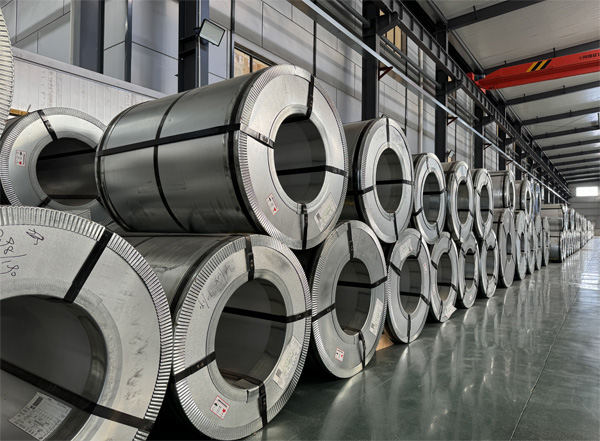In the world of modern manufacturing and technology, few materials are as critical to the performance and efficiency of electrical devices as silicon steel coil. Often found at the heart of transformers, electric motors, and generators, silicon steel coil plays a pivotal role in enhancing the functionality and energy efficiency of a wide range of electrical equipment.
The material is produced by rolling the steel into thin sheets, which are then wound into coils for easy handling and transport. These coils are often used in the production of electrical components that rely on magnetic fields to function, such as motors, transformers, and inductors. The specific properties of silicon steel coil, including its low core loss and high magnetic permeability, make it ideal for these applications.
Properties of Silicon Steel Coil
The key properties of silicon steel coil that make it highly valuable in electrical applications include:
High Magnetic Permeability: Silicon steel has an enhanced ability to conduct magnetic flux, which improves the efficiency of electrical devices. This means that silicon steel coils can generate a strong magnetic field with minimal energy loss, resulting in more efficient operation of electrical machines.
Low Core Loss: Core loss, also known as iron loss, occurs when energy is dissipated as heat in magnetic cores. Silicon steel’s low core loss means that it minimizes the energy wasted in electrical systems, improving the overall energy efficiency of transformers, motors, and generators.

Improved Electrical Resistance: The addition of silicon reduces the electrical conductivity of steel, which helps to minimize eddy currents—circular electric currents induced within the core material. These currents cause power loss, and by reducing them, silicon steel significantly enhances the efficiency of electrical equipment.
Excellent Magnetic Saturation: Silicon steel also exhibits high magnetic saturation, which allows for a greater density of magnetic flux in the core material. This makes it possible to design smaller and more compact electrical devices without compromising performance.
Ductility and Formability: Despite its high magnetic properties, silicon steel retains enough ductility to be easily formed into thin sheets and coils. This is crucial for creating components with precise specifications that fit the complex designs of modern electrical machinery.
Types of Silicon Steel Coils
There are two primary types of silicon steel coils: non-oriented and grain-oriented. The distinction between these two types lies in the alignment of the steel's crystal grains, which affects their performance in various applications.
Non-Oriented Silicon Steel: In non-oriented silicon steel, the grains are randomly oriented. This type is typically used in applications where the magnetic field direction is not fixed, such as in electric motors, home appliances, and other electrical devices that operate in multiple directions. It is often used in smaller transformers and appliances due to its cost-effectiveness.
Grain-Oriented Silicon Steel: Grain-oriented silicon steel is manufactured so that the grains are aligned in a specific direction, typically along the rolling direction. This alignment significantly improves the magnetic properties in one particular direction, making it ideal for transformers and large electrical machines where a strong magnetic field in a specific direction is required. Grain-oriented silicon steel coils are widely used in the production of high-efficiency transformers and electrical equipment that require precise control of magnetic flux.
Applications of Silicon Steel Coil
Silicon steel coils are integral to a wide array of industries, especially those that involve electrical energy generation and distribution. Some of the most common applications include:
Transformers: One of the primary uses of silicon steel coils is in the core of transformers, which are essential for adjusting voltage levels in electrical power systems. The high magnetic permeability of silicon steel allows transformers to operate efficiently with minimal energy loss, making them a critical component in power generation and distribution.
Electric Motors: Silicon steel coils are used in the cores of electric motors, where their magnetic properties enable the efficient conversion of electrical energy into mechanical energy. These motors are found in everything from household appliances to industrial machinery and electric vehicles.
Generators: In generators, silicon steel is used to create the magnetic field needed to convert mechanical energy into electrical energy. Its low core loss and high magnetic saturation allow generators to produce electricity with greater efficiency.
Inductors and Transformers in Electronics: Silicon steel coils are also used in the creation of inductors and transformers in various electronic devices, including computers, audio equipment, and communication systems.
Power Cables and Circuits: Due to their excellent conductivity and magnetic properties, silicon steel coils are used in the construction of power cables and circuit boards that transmit electrical signals and power.
Environmental Benefits of Silicon Steel Coil
The use of silicon steel in electrical equipment offers several environmental benefits. Its high energy efficiency translates to lower power consumption, which can significantly reduce the carbon footprint of electrical systems. Additionally, silicon steel is recyclable, making it an environmentally friendly material that supports the growing demand for sustainable industrial practices.
 +86-523 8891 6699
+86-523 8891 6699  +86-523 8891 8266
+86-523 8891 8266  info@tl-core.com
info@tl-core.com  No.1, Third Industrial Park, Liangxu Street, Taizhou City, Jiangsu, China
No.1, Third Industrial Park, Liangxu Street, Taizhou City, Jiangsu, China 

 English
English Español
Español Türk
Türk 中文简体
中文简体